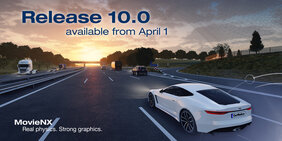More realistic and detailed – the release 10.0 of the CarMaker product family offers a variety of new and improved applications for virtual vehicle development. With MovieNX, virtualized test scenarios reach a completely new visualization level while being highly performant in complex scenarios. New functions enable a more detailed scenario generation as well. This is the response of the Karlsruhe-based company to increasing requirements and higher validation efforts in vehicle development driven by the dominance of software and electronics, interconnectedness and autonomous driving.
With the release 10.0, MovieNX becomes a regular feature of the CarMaker product family. Users can visualize existing TestRuns as well as highly complex new scenarios directly in the Scenario Editor. The successor of the well-known IPGMovie enables photo-realistic 3D visualizations in real-time and HDR, for example of special weather or light conditions such as fog, a low sun in the sky or reflections as well as artificial light in the dark. MovieNX allows to test camera-based advanced driver assistance systems and automated driving functions at a whole new level, and also to train and validate algorithms based on artificial intelligence. Thanks to the openness and seamlessness of the simulation solution CarMaker, real camera systems can easily be integrated and reproducible tests of autonomous driving scenarios performed via corresponding interfaces.
New, improved and more realistic sensor models
The sensor simulation technology becomes more realistic as well. With the enhancement of the Lidar RSI, reflective materials are no longer represented solely by their specular behavior but also by reflecting smaller amounts of light diffusely. This improvement is particularly visible on wet road surfaces or shiny car paints which can thus be depicted even more realistically.
The interaction model of the Ultrasonic RSI was extended by a physical wave scattering model, similar to the one of the Radar RSI. The new wave propagation takes into account every single interaction of the acoustic wave with the environment and improves the simulation results for complex geometries. Subsequently, the resulting acoustic pressure can be simulated in an even more realistic way.
A new function of the sensor GUI allows for an easy distribution of the computational processes of ray tracing-based sensor models on multiple graphics cards on one system (multi-GPU) as well as multiple graphics cards on different systems (GPU cluster).
Detailed scenario generation
Due to their numerous details and objects, city scenarios are a particularly challenging test environment for ADAS and AV applications. With the new CarMaker 10.0 functions, sophisticated road geometries of typical inner city scenarios can be created more easily. The road model can now reproduce complex traffic islands and sidewalks as well. In combination with the revised junction model, which allows for easy modeling of extensive real-world junctions, the degree of reality for the modeling of complex inner-city scenarios can be enhanced considerably.
In addition, the traffic simulation on freeways and multi-lane roads was extended to enable automated overtaking maneuvers. This reduces the modeling effort for complex freeway scenarios.
The functions and maneuver options of IPGDriver were also reinforced. They now assure a higher compatibility with the ASAM standard OpenSCENARIO.
IPG Automotive will present all new features to interested parties at this year’s Open House, starting April 28, 2021. This year, the event takes place online providing exclusive insights into the work of simulation experts and a variety of new application examples. Go to our website to find out more.
